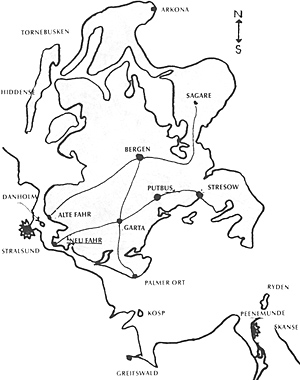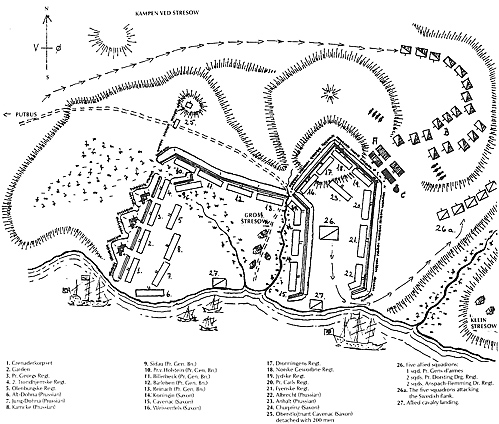 During the Great Northern War (1709-1720) Sweden tried its utmost to
keep its possessions in Northern Germany, especially Pommerania. In 1715
the three fortified harbors of Stralsund, Wismar and Stettin were still in Swedish
hands. Possession of Rugen was vital for Stralsund, the most important of the
fortresses, which could only receive supplies from there. The Swedes,
therefore, had a garrison of about 4,500 men on the island, and the troops were
led by Charles XII in person. Stralsund itself had a garrison of 15,000 men.
During the Great Northern War (1709-1720) Sweden tried its utmost to
keep its possessions in Northern Germany, especially Pommerania. In 1715
the three fortified harbors of Stralsund, Wismar and Stettin were still in Swedish
hands. Possession of Rugen was vital for Stralsund, the most important of the
fortresses, which could only receive supplies from there. The Swedes,
therefore, had a garrison of about 4,500 men on the island, and the troops were
led by Charles XII in person. Stralsund itself had a garrison of 15,000 men.
The Swedish troops on Rugen consisted of the following units:
CAVALRY
INFANTRY
There were 12 squadrons and 5 battalions in all,and in addition there was
a battery of 12 cannon.
During the latter half of 1715 the Danes and their allies, the Prussians and
Saxons, decided to seize possession of the island as a prelude to an assault on
Stalsund. They set aside a large force for the undertaking. The invasion corps
contained approximately 19,000 infantry and 3,500 cavalry. The Prussian
General Field Marshall Prince Leopold of Anhalt Dessau commanded the corps
with two Danish generals, Dewitz and Wilcken, as commanders of the cavalry
and infantry respectively. The force assembled at the end of October at
Greifswald. In the succeeding days under the protection of Danish Admiral
Sehested's squadron it embarked on many large and small vessels. On 12
November the fleet sailed with a course towards Palmer Ort.
It was not Sehested's intention, however, to allow the landing to take place
at Palmer Ort. Charles XII stood ready with his entire force there.
The intention was to sail to Putbus, and put the troops ashore at that
undefended place; but a powerful storm arose and the fleet was forced to
heave-to until 15 November when the wind became favorable again. The ships
with the cavalry temporarily remained off Palmer Ort to present the Swedes
with a continuous threat of landing. Sehested sailed with the infantry's ships,
unseen by the Swedes because of rain and mist, northeast to Stresow. Upon
arrival, he gave the ships containing the cavalry the signal to follow.
The allied invasion corps consisted of 10 Danish battalions and 16
squadrons, 10 Prussian battalions and 15 squadrons, 4 Saxon battalions and 2
squadrons, and 26 field cannon. Since the Danish primarily fought the battle, it
is only reasonable to provide their order of battle. It is as follows:
INFANTRY
CAVALRY
With a large Danish flag to mark the point of assembly, the troops rapidly
landed at Stresow. They met no resistance frorn a small group of Swedish
dragoons who were posted there. During two hours 10,000 infantry together with
the artillery were landed. Construction of a continuous earthwork with obstacles
of "Spanish riders" in front began immediately (see sketch). By 9:00 in the
evening it was in usable condition. The disembarkation of the cavalry went
naturally slower than that of the infantry. By 10:00 PM only 5 squadrons (3
Prussian and 2 Saxon) had landed.
Inside the earthwork the troops took up positions as follows (see sketch):
Furthest on the right flank, nearest the water, Fynske, Prins Carls, Jyske,
Norskme geworbne and Dronningens Livregiment with 2 Prussian battalions in
reserve; in the center 4 Prussian grenadier battalions and 1 Saxon battalion with
3 Saxon battalions in reserve; on the left flank the other 5 Danish battalions with
4 Prussian battalions in reserve. Cannon were placed between the battalions.
During the landing many of the soldiers had gotten wet, and a number of
bonfires were lit during the night to dry their clothes. This presented a
picturesque scene, but it also made it easier for the enemy to orient himself.
He did not wait. As soon as Charles XII saw the ships containing the cavalry
sail away, he selected a force of approximately 2,000 men and force marched
them toward Stresow. His general adjutant, Torstenson, with an advance
cavalry detachment had determined where the landing was occurring.
Everything indicates that Charles XII intended a similar maneuver which
15 years earlier had given him victory at Narva: direct a concentrated attack
on a single point, break through the defensive line and roll up the garrison from
the side. In this case the point chosen was a salient in the breastwork defended
by the battalion of the Jyske Regiment.
Between 3:00 and 4:00 in the morning the Swedes moved forward to
the attack. They formed in a narrow, deep column with 2 infantry
battalions leading under the command of Torstenson while the artillery
occupied positions. The Danish pickets discovered the column and
sounded the alarm. When the head of the column emerged from the
darkness, it was met by canister and musket fire. Without firing a shot,
the Swedish infantry pressed forward. They broke through the "Spanish
riders", and running, jumped down into the ditch where they tried to
climb the breastwork. The attack hit the Jyske Regiment with such force
that it momentarily wavered. It quickly recovered and opened a terrible
fire.
Soon two battalions of Prins Carls and the Norske geworbne
regiments came to its support. The Swedes were thrown back, and
Torstenson was left behind severely wounded. Charles XII, who had taken
a position at the Spanish riders, reformed his men and once again they
advanced. Once more a rain of fire poured down on the brave, advancing
Swedes who after a short, hand-to-hand combat, were again thrown back.
Although doubtful, it was now that the King is supposed to have
exclaimed: "Isn't there a God on my side any more?"
Fifteen minutes after the battle had begun, Prince Leopold had ordered
General Dewitz to advance with the five Prussian and Saxon squadrons,
the only ones which were formed after the landing, and fall on the flank of the
enemy. The attack, however, was initially repulsed by the Swedish cavalry
which offered stiff resistance. A bloody fight developed which after a while
developed into a rear guard battle. The entire Swedish force had to retreat
because of the intense pressure. The King himself lay wounded under his horse
with a musket ball in his chest. It was only with difficulty that he was carried
back at the last moment.
The losses in the battle which lasted hardly more than an hour were great.
The Swedes lost all of their artillery, and the infantry for all practical purposes
was destroyed. Three generals were dead and one was mortally wounded.
Besides there were 500-600 dead, wounded and captured. Of the defenders only
the three Danish battalions were under fire, and they lost a total of four officers
and 89 men killed and wounded. Thejyske battalion had distinguished itself, and
Prince Leopold praised them in high terms. When the battalion was attacked the
second time a Prussian general recommended that reserves be sent forward.
The Prince is reported to have said: "No! They have already wounded and
repulsed the enemy, and they alone have held the work, so they alone must
have the honor." In the cavalry battle the Saxons lost two officers and 34
dragoons. The Prussians had a loss of 49 men.
After the battle the Swedes retreated to a large earthwork at Altefahr under
whose protection they began to embark for Stralsund. Nevertheless, 1,200 of
them deserted to the allies. In the meantime General Dewitz with the cavalry
and General Wilcken with the Danish infantry followed after the enemy. The
day after the remaining Swedish force surrendered. Four generals, 99 officers
of other grades, and 540 NCOs and men were taken prisoner by the Danes
toward taking Stralsund. One outwork after another was captured, and several
Swedish sorties were repulsed. On 22 December Charles XII left the fortress by
ship, and reached Sweden safe and sound although the Peter Wessel was
cruising the waters in an attempt to capture him. Two days later, Christmas Eve
1715, Stalsund capitulated.
Tuxen, generallojtnant A.P. and kommandor C.L. With-Seidelin, Embringen at Sveriges Tyske
Privinser 1715-1716. 1922.
[1]A Holstein-Cottorp regiment which entered Swedish service on 15 May 1714.
This article originally appeared in CHAKOTEN the magazine of the Danish
Military History Society in 1969. The Society has kindly given its permission to
translate and print the article in THE COURIER. All endnotes are the
translator's.
Drabants
Bremiska dragonreg:te
Bremiska kavallerireg:te
Verdiska dragonreg:te
Holstenska kavallerireg: te [1]
Wismarska dragonreg:te
Pommerska regementet till hast
Barthska dragonreg:te
Holstenska Cardedragoner [2]
Benderska dragonreg:te [3]
Franska dragoner [4]
Niesterska dragonreg:te [5]
Jonkoipings regemente
Rugenska Marinereg:te [6]
Holstenska infanterireg:tet [7]
Bremiska infanterireg:tet
Rhenlandska infanterireg:tet [8]
Caren til Fods, 1 Bn
Prins Carls Regiment, 1 Bn
Grenaderkorpset, 1 Bn
Scholtens regiment, 1 Bn
Jyske Regiment, 1 Bn
Norske geworbne Regt., 1 Bn
Fynske Regiment, 1 Bn
2.Trondhjemske Regt., 1 Bn
Dronningens Livregiment, 1 Bn
Oldenborgske Regiment, 1 Bn
2. Jyske Rytterrgmt., 2 Sqds
Livregiment Dragoner, 2 Sqds
3. Jyske Rytterrgmt., 2 Sqds
Dewitzs Kyrasserer, 2 Sqds
2 Fynske Rytterrgmt., 2 Sqds
Wurttembergs Kyras., 2 Sqds
Holstenske Rytterrgmt., 2 Sqds
Jyske Lanclkyrasserer, 2 Sqds
SOURCES
Biorlin, generallojtnant Custaf. Sveriges Krigshistoria.
Johansen, oberstlojtnant Jens. Danmark-Norges Deltagelse i Denstore nordiske Krig. 1935.
Vaupell, 0. Den Dansk-Norske Haers Historre, Vol. 1. 1876.
Boeck, Hector. 12. Bataillons Historie 1679-1929. 1929.
ENDNOTES
[2] Another Hostein-Gottorp regiment which entered Swedish service in 1714 also.
[3] Raised from Swedish soldiers in Bender where Charles XII was in exile following Poltava.
[4] Raised by the Commandant of Stettin, Meyerfelt, presumedlyfrorn French prisoners of war and deserters. The regiment had a strength of 95 men at this time.
[5] Raised from Poles in 1712 who accompanied Charles XII into exile in Bender.
[6] Known as the Marine Regiment because its colonel was Vice Admiral and Commander of the Stralsund and Rugen Fleet, Michael Henck,
[7] Another Holstein-Gottorp regiment. Also known as Baner's Regiment.
[8] Entered Swedish service in 1714. Previously in the pay of the Maritime Powers during the War of Spanish Succession. Its commander was Carl Magnus Leutrum.
Fortification Map

Back to Table of Contents -- Courier #56
To Courier List of Issues
To MagWeb Master Magazine List
© Copyright 1991 by The Courier Publishing Company.
This article appears in MagWeb (Magazine Web) on the Internet World Wide Web.
Other articles from military history and related magazines are available at http://www.magweb.com